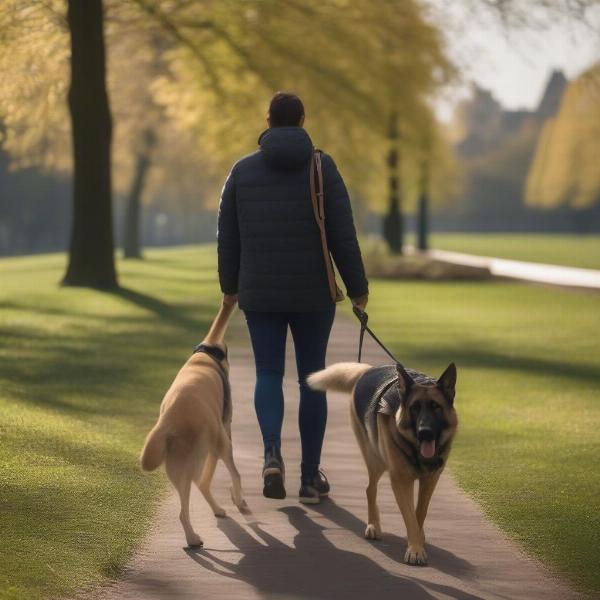Seeing eye dogs, also known as guide dogs, play a vital role in providing independence and mobility to visually impaired individuals. These highly trained canines undergo rigorous training programs to navigate complex environments and keep their handlers safe. This guide delves into the world of seeing eye dog training, covering various aspects from puppyhood to partnership.
The Journey of a Seeing Eye Dog: From Puppy to Partner
The journey of a seeing eye dog begins long before they are matched with a handler. Careful selection and early socialization are crucial for a successful career. Breed selection often focuses on temperament, intelligence, and physical characteristics suitable for the demanding work. Common breeds include Labrador Retrievers, Golden Retrievers, and German Shepherds, known for their intelligence, trainability, and calm demeanor.
Early Stages of Training: Building a Foundation
From a young age, puppies destined to become seeing eye dogs are exposed to a variety of sights, sounds, and environments. This early socialization helps them develop confidence and adaptability. Basic obedience training, including commands like “sit,” “stay,” “come,” and “heel,” is also introduced during this phase. Positive reinforcement techniques, such as praise and treats, are essential for motivating the puppies and building a strong bond with their trainers.
Specialized Training: Navigating the World
As the puppies mature, their training becomes more specialized. They learn to navigate obstacles, cross streets safely, and respond to their handler’s commands in various situations. Training involves exposure to real-world scenarios, including busy streets, public transportation, and crowded areas. The dogs learn to judge height and width clearances, identify potential hazards, and make independent decisions to ensure their handler’s safety.
The Importance of Socialization and Obedience
Socialization and obedience are paramount for seeing eye dogs. They must remain focused on their handler while navigating busy environments, ignoring distractions and maintaining composure in challenging situations. Regular training sessions reinforce these skills and ensure the dogs are well-prepared for their future role.
Matching a Dog with a Handler: A Perfect Partnership
The process of matching a seeing eye dog with a handler is carefully considered. The organization assesses the handler’s lifestyle, mobility needs, and personality to find a compatible canine partner. Once a match is made, the handler and dog undergo intensive training together to solidify their bond and ensure a seamless transition.
 Seeing eye dog and handler partnership
Seeing eye dog and handler partnership
Ongoing Support and Continuing Education
Even after a seeing eye dog is placed with a handler, the organization provides ongoing support and continuing education. Regular check-ins and refresher training sessions help maintain the dog’s skills and address any challenges that may arise.
Conclusion: A Lifechanging Partnership
Seeing eye dogs are more than just companions; they are lifelines for visually impaired individuals. Their specialized training, unwavering dedication, and unwavering loyalty empower their handlers to navigate the world with confidence and independence. The journey from puppy to partner is a testament to the remarkable capabilities of these incredible animals.
FAQ
-
How long does it take to train a seeing eye dog? Typically, training takes approximately two years.
-
What breeds are commonly used as seeing eye dogs? Labrador Retrievers, Golden Retrievers, and German Shepherds are frequently chosen.
-
How are seeing eye dogs matched with their handlers? Organizations carefully assess the handler’s needs and lifestyle to find a compatible match.
-
What kind of training do seeing eye dogs receive? Training includes obedience, navigation, socialization, and specialized skills for guiding visually impaired individuals.
-
What happens after a seeing eye dog is placed with a handler? Organizations provide ongoing support and continuing education to ensure the partnership’s success.
-
How can I support seeing eye dog organizations? Donations, volunteering, and spreading awareness are all valuable ways to support these vital programs.
-
Can any dog be trained to be a seeing eye dog? No, only dogs with specific temperaments, intelligence, and physical characteristics are suitable.
Related Articles on ILM Dog
ILM Dog is your trusted resource for all things dog-related. We offer expert advice on dog breeds, health, training, nutrition, grooming, and more. Whether you’re a new dog owner or a seasoned pro, ILM Dog has the information you need to provide the best possible care for your furry friend. Our expertise covers a wide range of topics, from choosing the right breed to understanding canine health and behavior. Contact us at [email protected] or +44 20-3965-8624. Visit ILM Dog today for more information.